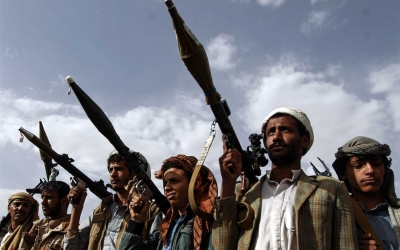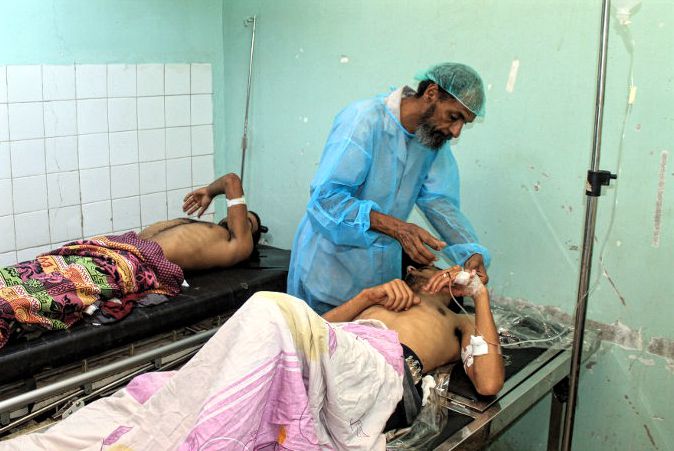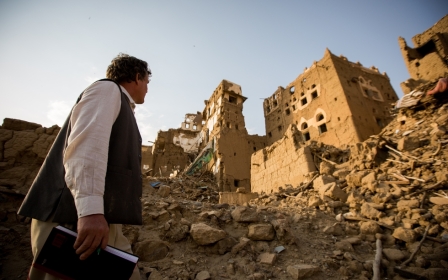The sniper: How a Yemeni shopkeeper kills to 'liberate my city from invaders'
Taiz, YEMEN - "Ahmed", like many Yemenis, used to enjoy walking in the mountains overlooking Gabal Habashi in western Yemen, especially during the holidays.
Often they would shoot at tin cans. That’s no surprise in Yemen, which has the second highest rate of gun ownership and where most families have at least one Kalashnikov rifle, which is fired into the air during celebrations such as weddings.
On the second day of Eid, locals in Ahmed's village would organise sharp-shooting contests. Ahmed, who is in his early thirties and goes by another name, knew he was one of the best shots in his village.
When the conflict came to his region in August 2015, the shopkeeper with no experience of military service decided to sign up. His Kalashnikov was one of the better models and more adaptable than other weapons for sniping.
New MEE newsletter: Jerusalem Dispatch
Sign up to get the latest insights and analysis on Israel-Palestine, alongside Turkey Unpacked and other MEE newsletters
"I joined the resistance to liberate my province from the Houthis, who came from Saada to spread Shia thoughts in my province," he told Middle East Eye. “I would be a coward if I do not fight the Houthis rebels. Fighting the Houthis is jihad and Sunnis have to fight for their religion.”
Some people he knew became fighters on the front lines, others drove military vehicles. But for Ahmed there was only one choice. "I preferred to join as a sniper because I have experience in this field.”
The first kill
Ahmed's first experience of battle came a few weeks later, in September, at al-Haseb in Taiz. At first he found it difficult to kill enemy fighters.
But then he learnt how, working beside another sniper with experience. In Taiz, snipers tend not to work alone: if the Houthis make a quick advance then it requires more than one shooter to keep them at bay. And when Ahmed saw the casualties produced by his colleague, he dared to shoot.
'The first time, I hesitated to fire, but my colleague encouraged me to do it. So I did and I felt I was doing something great to liberate my city from invaders'
"The first time, I hesitated to fire," he recalls, "but my colleague encouraged me to do it. So I did and I felt I was doing something great to liberate my city from invaders. Since then I have been working as a sniper."
With his Kalashnikov, Ahmed has now served in conflicts in al-Dhabab, al-Gahmalya, al-Askari, Thaabat and other parts of Taiz, mostly in near-deserted residential districts. For the resistance, their role is a valuable one in the crowded warren of streets that constitutes Yemen’s second biggest city.
"We work out of hidden places,” he explains, “sometime from houses, sometimes behind rocks, often behind barricades. We tend to stand behind the fighters, so if the enemy advance towards us, we can withdraw easily. It means we are safer than fighters, and are in less danger of being killed.”
The Kalashnikov is, he admits, not the best firearm for snipping, but it is the one he grew up using.
"I inherited this rifle from my father,” he recalls, “and I have used it since I was a child. It’s the best one for me and I wouldn’t be able to do what I do with another one.
“There are American rifles with sights, which are the best, but the resistance does not have enough for all the fighters. Those are given to the new snipers as it is makes it easier for them.”
Instead Ahmed uses binoculars to sight his targets. When there is an attack by the Houthis or an offensive mounted by the resistance, Ahmed and his colleagues are shooting all the time. But during a typical day they spend much of their time observing the advancing Houthis, before trying to eliminate them.
Snipers like Ahmed are paid YR2000 ($8) per day, the same as other resistance fighters. He keeps half of that to cover his daily living expenses while the rest goes home to his family. But he did not join the resistance for the money.
"I shoot the Houthis with my own Kalashnikov, which cost more than $1,600. I am not in dire need of money. I joined the battle to liberate my province from invaders who want to spread Shiite thoughts in Taiz."
The snipers work as a tight unit, with their own leadership structure, meeting each month to discuss their progress and brainstorm ideas, such as new lookout positions.
They also send observations about enemy positions to the resistance leadership, who then coordinate with the coalition to launch air strikes against the Houthis before they advance.
So how many people has Ahmed shot?
He pauses. He knows it's at least 10 Houthi fighters. But beyond that - uncertainty. "I cannot give you an exact number because we fire randomly during attacks," he explains.
Living in a snipers' zone
The Houthis, who also have their own snipers, have laid siege to Taiz city with snipers and landmines, shooting anyone who tries to enter from the main roads.
'Mohammed wanted to get to the hospital as soon as possible to see his uncle. But he arrived himself, as a dead body, because of the odious snipers'
Tallal Abdulwali, resident
Snipers from both sides accompany fighters on the battlefield - but in Taiz, the conflict zones are in the city, which is full of resident civilians. Both sides say they only target enemy fighters - but civilians are often caught up in the conflict.
In March 2015, snipers in al-Dhabab, southwest of Taiz city, killed photojournalist Mohammed al-Yemeni and injured two of his colleagues as they were accompanying resistance forces breaking the siege on Taiz city.
"I am proud of my work as a sniper,” Ahmed says. “I do not feel I have committed any sin, I have not killed any civilians. But sometimes journalists and photographers accompany armed forces on the battlefield - and snipers cannot tell the difference between journalists and fighters.
"If you live in a conflict zone in Taiz province, you have to pass through specific roads. If are a stranger do not try to enter a conflict zone, as there are snipers waiting to shoot you."
Ahmed says: "Some residents insist on crossing a zone of conflict, which is being targeted by snipers from both sides. Then both of the Houthi and the resistance snipers will fire on passersbsy and they become innocent victims.”
Mohammed Abdulwali, 29, lived in the city’s al-Zahraa district, a conflict zone under the observation of the Houthis. When his brother told him that his uncle was sick, he set off on his motorbike down a road under the observation of snipers.
Mohammed's brother, Tallal, told MEE: "Mohammed wanted to get to the hospital as soon as possible to see his uncle. But he arrived himself, as a dead body, because of the odious snipers.
“We have not left the city because of the danger of snipers - not because of clashes or missiles. Snipers are a hidden danger in the city.”
'My family are proud of me'
Ahmed's family and friends know what he does. He says they are proud of him: many residents from his area are fighters with the resistance.
He admits that some of his friends regard him as a killer – but then says he has persuaded them that he is only killing Houthis, not civilians.
"I visit my family in the village every month and my daughters cry before I leave the house,” he explains.
“They insist on me to staying beside them, but they are still children and they do not know the dangers of the Houthis.
“I do not want to be a sniper, but the Houthis forced me to do it. I only want to return my house for the sake of my two daughters."
This article is available in French on Middle East Eye French edition.
Middle East Eye delivers independent and unrivalled coverage and analysis of the Middle East, North Africa and beyond. To learn more about republishing this content and the associated fees, please fill out this form. More about MEE can be found here.









